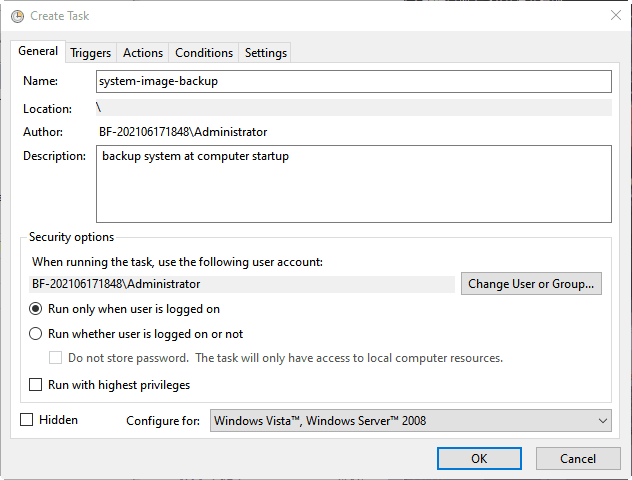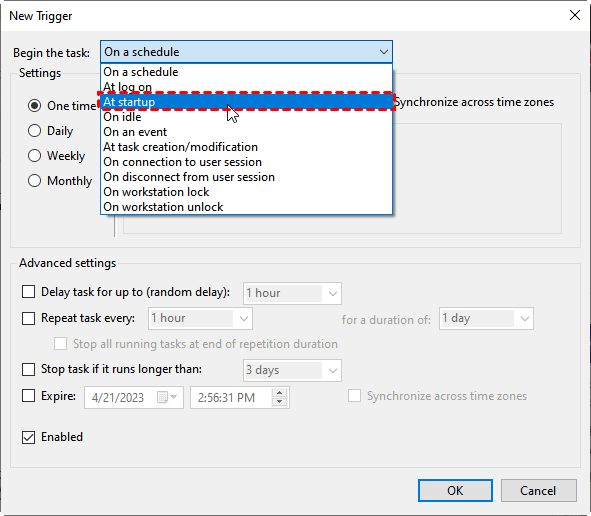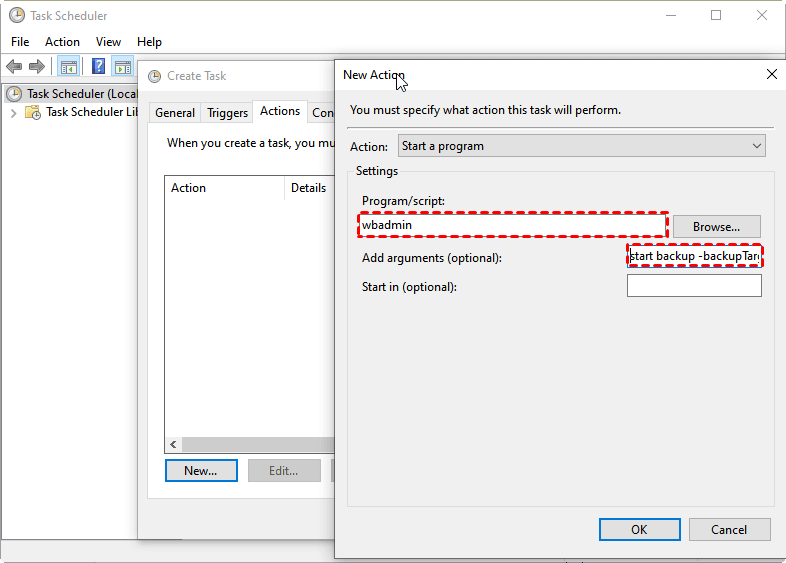How to Automatically Backup File Using Task Scheduler?
The schedule settings in Windows Backup is not adequate
There are several ways that can cause your data loss, like system crash, hard drive failure, virus infection, theft, etc. Windows provides many backup and recovery options to help you protect your data.
In Windows 7, you can create System Restore Points to protect your system state and previous versions of files, and Backup and Restore to create image backup including system image and files. In Windows 8, Microsoft has introduced File History to backup multiple versions of your personal files. In Windows 10, Microsoft adds OneDrive that allows you to backup data to cloud drive.
Some of these backup options support automatic scheduled backup, but the schedule options are limited, which you may not content with. In that case, you can use the help of Task Scheduler, a built-in tool allows you to automatically perform routine tasks, to run scheduled backups in a more flexible way.
Configure auto backup folder with Task Scheduler
Besides run a backup at a specific time daily/weekly/monthly, task scheduler allows you to initialize a task a trigger chosen is met. There are a lot of triggers that you can choose like when a specific system event occurs, when the computer is in an idle state, when the system is loaded, when a user is logged on.
Sounds good? Then you can follow the steps below to set up a scheduled backup to backup full sytem system:
- You can press Windows + R to open a Run window. Type “taskschd.msc” in the Run box and press Enter to open Task Scheduler. You can also access Task Scheduler from Control Panel -> System and Security -> Administrative Tools.
- Click Create Task to begin the settings.
- In General, set a task name and write a description.Check the option Run whether user is logged on if needed.
- Under Triggers tab, click New to create a new trigger. You can add whatever trigger you want. If you want to trigger the backup at computer startup, just select At startup and click OK.
- Under Actions tab, Click New to add. Type “wbadmin” in the Program/script box, and type “Proceed -backupTarget:F: –include:C:\Users\My documents” (without quotes) in Add argument (optional). If you need to include other files in the backup, just change the WBadmin backup command parameter. For example, if you want to add system image into the backup, just add the switch “-allcritical” (without quotes).
- Click OK and type in your user password. Then you can see the task in the Task Scheduler Library.
Besides System image backup, your files are also important. In Windows 10/8/7, System Restore Points not only backup your system state, but also save file versions so you can restore them to previous version.
If you think the time gap between each restore point is too long, you can also use Task Scheduler to take system restore points.
Customize previous versions frequency with task scheduler
Once you have enabled System Protection in Windows 7/8/10, the task to perform system restore points has been added to Task Scheduler. You can find it through Task Scheduler Library -> Microsoft -> Windows -> SystemRestore. Locate the task named “SR”, and double-click to edit it. You can either change the trigger or add new triggers.
Advanced way to automatically backup files with Task Scheduler
Although Windows already provides many backup and restore features, they all have some limitation. For example, Windows Backup can only protect volumes formatted with NTFS . If you do like the built-in backup features, then free backup software Qiling Disk Master Standard is recommended.
Qiling Disk Master allows you to backup files, system and entire hard drive or SSD drive into a compressed image file. It already provides you enough options to schedule a custom backup. What’s more, you can also use Task Scheduler to run the backup.
Follow the To set up auto backup folder in Windows 7/8/10, download this free backup software first:
- Install Qiling Disk Master and run it on your computer. Select “File Backup” under “Backup” tab.
- Click “Files” to include the files or “Folder” to include folders in the backup.
- Click to select a location as receive the image backup file.
- Click Schedule to create a scheduled backup task. In the Schedule Settings, you have many options including daily, weekly, monthly, event triggers and USB plug in. (The last two options are in advanced version, Professional.)
✍ Note: If you like to use this freeware to handle the scheduled backup, you can just click OK and go to the next step. If you want to Task Scheduler to run the backup, click on the Advanced tab, and check the option Use Task Scheduler to run this backup.
- Click “Proceed” to start this file backup.
- Go to Task Scheduler to find this task and edit it if need be.
- After that, you can create a bootable media under Tools, so you can restore files when you can unable to boot into Windows. Besides backup and restore, the advanced version of this software also allows you to create File Sync task, schedule backup to cloud drive, or clone hard drive to another one to protect your data.
- This software also provides its own cloud storage device for its users - Qiling Cloud, you can use it for cloud backup to better protect data security and save disk space. After you sign up for an Qiling account, it gives you 1TB of free storage for 15 days.
Final words
Above are three methods to backup file using Task Scheduler. Which one do you prefer? If there any other good methods or tool to automatically backup files? Leave your thought in the comment section.
The free backup software provided in this article can not only help you back up your files regularly, but also help you migrate your data and operating system when you upgrade your computer's hard drive.
Related Articles
- Best Free Task Scheduler Alternative - Qiling Disk Master
If you are looking for a better Task Scheduler alternative, Qiling Disk Master Standard is worth trying. Read this article carefully and learn the operating steps below. - How to Schedule SyncToy in Windows 10 to Run Automatically
Wanna schedule SyncToy in Windows 10 but don't know how to do it? Read this article to get the answer and find the best free alternative to SyncToy. - How to Schedule Windows 10 Wake from Sleep
This article is written for users like you who want to schedule sleep and wake in Windows 10 at a certain time, then run scheduled backup task. Scroll down to learn more. - Set Task Schedule Log Off and Backup Windows on Log Off
You can learn how to easily log off user with or without task scheduler. Also, with the help of a professional backup software, a user logoff schedule backup is supported.









